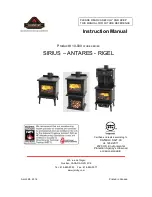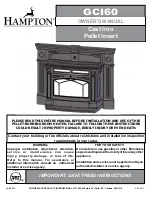
Manual_S5_Airplus_2015_04_20
Page 26 / 68
©
Wodtke GmbH - Tübingen. All Rights and Changes Reserved.Printed 04/2015
Part No. 950 976
8.4.6
"Reserve 4" Output (Operating
Message with Monitored Safety Re-
lay)
2-pole, potential-free, forcibly actuated and moni-
tored relay output (normally closed); max. 2 A load
capacity: for connection of external devices which
require a potential-free opening signal during op-
eration of the furnace (e.g. wodtke DS01 differen-
tial pressure controller or wodtke C-Box 1).
Fig.. 51: Reserve 4 output
Output R4 ON = relay open = furnace in
operation. Note: G OFF applies as opera-
tion.
Output R4 OFF = relay closed =
furnace off or furnace not ready (e.g. voltage
failure, furnace shut down via
button or
furnace shut down via external / internal con-
troller).
Notice regarding "Reserve 4" output:
The "Reserve 4" output switches simulta-
neously with the "Reserve 1" output be-
cause both outputs represent an operating
message of the furnace. Difference: R1 =
normally open contact with 230 V; R4 =
normally closed contact, potential-free and
monitored.
If there is a malfunction on the "Reserve 4"
output (relay does not open or close), the
control recognises this, shuts the furnace
down and reports "R4 Er1"
9
Furnace and Functional De-
scription, Components, De-
scriptions
A wodtke AIRPLUS Pellet Primärofen is a special-
ised heating unit for burning wood pellets only.
During heating operation, the furnace generates
hot air which is emitted to the installation room. In
addition, comfortable radiant heat is generated
from the panelling and the viewing window. For
heating operation, simply switch on the Pellet
Primärofen and select the desired output stage.
When using an external controller, the wodtke Pel-
let Primärofen can also be automatically activated
and deactivated and the output stage automati-
cally modulated.
The wood pellets are fully automatically conveyed
to the burner pot and ignited by an electrical ig-
niter.
The controlled transport screw automatically deliv-
ers the correct volume of fuel according to the se-
lected heating output. The air required for com-
bustion flows to the burner pot in a controlled man-
ner. The gases combust in the combustion cham-
ber and the downstream hot gas flues and emit
their energy to the heat exchanger.
An exhaust fan is located at the end of the hot gas
flues which safely conduct the flue gases to the
chimney, coordinated with the fuel volume and
combustion air. An air volume sensor in the air in-
take pipe measures the incoming combustion air
volume and compares it to the related target air
volume. In case of deviations, the exhaust fan is
regulated up or down accordingly. Operating
sounds, such as pellets dropping and flame/air
current and drive motor noises, are audible during
operation. By pulling out the cast grate, ash can
fall out of the burner pot / combustion chamber into
the ash drawer below. The ash drawer must be
regularly removed and emptied. If the ash drawer
is full, faults can occur.
The furnace is also prepared for room air inde-
pendent, sealed installation. Consequently, there
is a contact switch on the combustion chamber
door which registers when the combustion cham-
ber door is opened for too long during operation,
and triggers corresponding safety functions. The
storage container is also correspondingly safe-
guarded and should likewise only be opened
briefly.
Attention:
If an external loading system is connected, room
air independent operation / installation is no longer
possible or permitted, as the seal tightness of the
furnace is no longer guaranteed as a result of the
customer-provided attachments. The same ap-
plies in the case of changes to the furnace made
by the customer, such as the drilling of holes in the
furnace casing. This voids approval.
The operator must clean the furnace of ash and
slag at regular intervals. The viewing window must
also be cleaned of ash coating which is always
created during combustion of solid fuels. In addi-
tion, regular maintenance is required, which
should be performed by a specialist company but
can also be carried out by an instructed operator.
















































